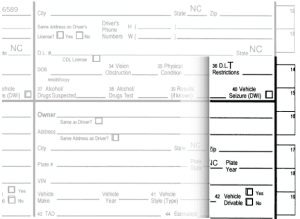
Crash Report Lawyers in Durham
Understanding Your DMV-349 Report in North Carolina
If you plan on representing yourself or handing any portion of your personal injury claim, property damage, medical payments, or diminished value claim, it is essential that you understand what has been reported about your accident. The crash report (DMV-349) is potentially one of the most valuable documents that you can obtain relating to your car accident claim. Understanding what is involved in making the report, who makes the report, and how it can be used is as important as understanding the information within the report.
In North Carolina, the crash report is called the DMV Accident Report form or DMV-349. DMV-349 is used by all North Carolina Law enforcement officers to report vehicle-related collisions to the Division of Motor Vehicles.
A collision is reportable by North Carolina law if it meets one of the following:
- The accident resulted in a fatality
- The accident resulted in a non-fatal personal injury
- The accident resulted in total property damage amounting to $1,000 or more
- The accident resulted in property damage of any amount to a vehicle seized
After your accident, one of the most important steps that you can take is to get your hands on a copy of your crash report. DMV-349 is a document that memorializes the accident. The police officer that responds to the scene will gather information, complete the form, and provide the information to the DMV. The completed form will include information such as driver and passenger information, vehicles involved, insurance providers, contributing circumstances, and a host of other factors.
Call Wallace Pierce Law for your consultation at (919) 313-2737, or contact us online. Se habla español.
What Important Information Does the Crash Report Have?
A completed DMV-349 form contains a vast and sometimes overwhelming volume of information, ranging from documenting the road conditions to correctly identifying the owners of all the vehicles involved in the accident. Due to the significant amount of information contained within it may be easy to become confused and frustrated when trying to read your crash report.
Once you have obtained your DMV-349, please review it carefully. It is very important to assure that the accident report is as accurate as possible. Responding officers are often rushed and may make a mistake on the documentation because they are responsible for securing the scene, gathering information, and resuming a normal flow of traffic. Additionally, responding officers have limited information to make their conclusions on due to unclear mechanics, lack of witnesses, or the account of only one involved party. For the reasons provided, it is extremely important that the information on the DMV-349 is accurate because it is somewhat common for the accident report to misidentify vehicles, drivers, or misstate the mechanics of the accident.
One of the most important pieces of information that’s contained in the DMV-349 is the list of contributing circumstances. Contributing circumstances are those that the investigating officer determined to be involved in causing the accident (it is possible that there are several listed in the report). These contributing circumstances in a nutshell are the officer’s determination or opinions as to what actions a particular driver took, or failed to take, that contributed to the crash. Since these circumstances are so important, it is imperative that you review your accident report to assure that what happened in the accident is properly documented.
Another reason that the accuracy of your accident report is important is it may impact your claim when dealing with insurance adjusters. The DMV-349 will be used by the insurance adjuster as a significant factor in his or her determination of liability. Since the accident report is relevant to the outcome of your claim, it’s important that you obtain a copy and make sure what’s on the report is accurate. If you feel that your crash report is inaccurate in any way, you may take steps to have it amended.
-
“When my 4-year old son and I were involved in a terrible head-on collision, I wasn't sure where to turn. Wallace Pierce has been great showing me the way!”- Mary P.
-
“Richard Dingus is a great attorney! And I think the best, serving in the state of North Carolina. I would recommend him for injury and bodily claim any day.”- Isaac B.
-
“They were concerned not only about getting our vehicle replaced, but more importantly my kid’s full recovery.”- Coral M.
-
“I retained this law firm to fight my case. I was completely shocked at the amount I received once the case was won.”- Schjuana S.
-
“Mr. Pierce gave me practical advice and was very thorough in guiding me through the process. I left with a strong and positive impression of him.”- Audria L.
-
“Was able to either point me in the right direction or answer any questions I had regarding the accident I was in. Thank you!”- Steven L.
-
“Great Law Firm, Friendly Staff, Amazing Service. Willing to help you every step of the way.”- Caleb M.
-
“I could not recommend anyone any higher than I recommend Wallace Pierce Law, they get the job done and they do it quicker and better and keep you informed along the way.”- Debby L.


featured
Our top priority is to devise customized legal strategies that are tailored to the unique legal needs of our clients, no matter how simple or complicated their situations, might be.
-
$1,900,000 Wrongful Death
The at-fault driver failed to reduce speed and collided with our client's vehicle. Our client passed away shortly after the collision.
-
$900,000 Wrongful Death
Our client was thrown from his motorcycle and was pronounced deceased on the scene.
-
$122,000 Car Accident
Vehicle made a left-hand turn, failing to yield the right of way.
-
$104,000 Serious Injuries
Client was a passenger in a vehicle that was driving through an intersection when another vehicle ran a stop sign and t-boned the vehicle our client was in.
-
$104,000 Severe Injury
We were able to not only receive policy limits for our client but were able to negotiate her medical bills and liens to ensure that she was able to keep a good portion of the settlement.
-
$102,000 Serious Injuries
Elderly client was a passenger in a vehicle that was t-boned in an intersection where a driver failed to yield the right of way.
 the right-hand side of the first page of your crash report. The contributing circumstances boxes are labeled No. 14 – 19. The activity or actions of the individual drivers, which may have caused or contributed to the accident, are listed in boxes No. 14 – 19 and document the cause of the accident and not necessarily any traffic citations issued.
the right-hand side of the first page of your crash report. The contributing circumstances boxes are labeled No. 14 – 19. The activity or actions of the individual drivers, which may have caused or contributed to the accident, are listed in boxes No. 14 – 19 and document the cause of the accident and not necessarily any traffic citations issued.